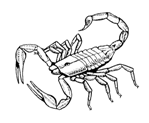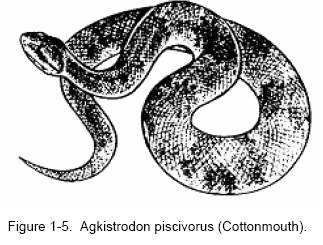INTRODUCTION
1. SNAKEBITES
Exercises
2. BITES AND STINGS.
Section I. Spiders
Section II. Insects
Section III. Fire Ants, Scorpions, Centipedes &
Millipedes
Section IV. Injuries From Marine Life
Exercises
3. ANAPHYLAXIS & ANAPHYLACTIC SHOCK
Exercises
4. HEPATITIS
Section I. General
Section II. Type A Hepititis
Section III. Type B Hepititis
Section IV Other Types of Hepititis
Exercises
Appendix A Snake Venom Poisoning and Antivenins
Appendix B Glossary
------------------------
LESSON 1
SNAKEBITES
1-1. GENERAL
An emergency that can occur, that is not directly
related to a combat area, is the bite of a snake. As a Medical NCO
responsible for caring for a variety of patients, the information
contained in this lesson concerning snakebites is invaluable because a
snakebite can occur almost anyplace. A snake will avoid mankind
usually, unless it is injured, trapped or somehow disturbed: n these
cases, it will defend itself. An aggressive type of snake may attack
without apparent provocation. Snakes tend to display more
aggressiveness during their breeding season. Although there are over
2,500 known species of snakes in the world, less than 200 are
potentially dangerous. All species of snakes can swim, and many of the
snakes can remain under water for long periods without drowning. A
bite sustained in water is just as dangerous as one on dry land. Often
the thought of a snakebite creates fear and confusion, combined with
anxiety about what to do, but this is needless and groundless when
first aid for snakebites is understood.
1-2. CLASSIFICATION OF VENOMOUS REPTILES
a. Family Helodermatidae.
The two lizards of the Helodermatidae family are the Gila
monster (Heloderma suspectum) and the beaded lizard, scorpion (H.
horridum). These lizards are unique because they have grooved teeth
and venom glands. They can be found in the southwestern part of the
United States and in Mexico.
The Gila monster is a large, corpulent, relatively
slow-moving and largely nocturnal reptile, and may reach an overall
length of 550 mm. Its life span is 10 to 25 years, and some records
have noted even as many as 27 years. The location of the Gila
monster's venom glands is on either side of the lower jaw. The glands
consist of several lobes, and there is a separate duct for each gland
to carry the venom to the mucous membrane between the lower jaw and
the lip and the lip near the base of the tooth. Through capillary
action, the venom travels from the duct to the grooves of the lower
teeth, then the venom is drawn into the puncture wound made by the
tooth.
It is relatively rare that a Gila monster bites unless
there has been careless handling of it during captivity, it may not
always expel venom. The venom has local irritant hemotoxic and
neurotoxic effects.
b. Family Colubridae.
Of the over 1000 species of snakes in the Colubridae family,
there are some 200 venomous species. The boomslang (Dispholidus
typhus) of South Africa and the bird snake (Thelotornis kirtlandii)
are found in this group. They are found in mostly tropical and
subtropical areas and have grooved fangs on the posterian maxillae
(rear fangs). Although little is known concerning the venoms, some are
powerfully hemorrhagic. This venom has been implicated in fatal
envenomations.
c. Family Elapidae.
The snakes of this family are referred to as the elapids and
include over 150 species of coral, (Figure 1-3) and venomous snakes of
Australia. The coral snakes have bright rings of red, white or yellow,
and black across their bodies to make them the most beautifully
colored of the venomous snakes. Corals are relatively small snakes and
their secretive and burrowing habits keep contact with humans rather
rare and bites even rarer. The eastern coral snake (Micrurus fulvius),
the Texas coral snake (M. Tenere), and the Arizona or Sonoran coral
snake (Micruroides euryxanthus) are found in the United States. They
are fixed fangs on the anterior ends of the maxillae and the venom is
predominately neurotoxic and potent.
d. Family Hydrophidae.
There are approximately 100 species in this family. The words
"adder" and "viper" are commonly used in literature and in a few areas
of the world. "Adder" may be used to described nonvenomous snakes
(i.e., hognose and milk snake in North America). These snakes can be
found in Southeast Asia, the southwest Pacific Islands and one species
reaches the western coasts of tropical America. They have short fangs
and the venoms act primarily on skeletal muscle. The venom of these
snakes is often extremely potent but small in quantity.
e. Family Crotalidae.
There are approximately 100 species of Crotalidae. Many are pit
vipers. The best-known pit vipers are the rattlesnakes. Rattlesnakes
are found in North, South, and Central America and all of them are
venomous. With the exception of Crotalus catalinensis, all
rattlesnakes have rattles. They are relatively heavy bodied, have
broad heads and are marked with blotches or cross bands over the back.
In addition to the rattlesnake, some common names of snakes in the
family.
Crotalidae are moccasins, new world pit vipers,
bushmasters, massasaugas and pygmy rattlesnakes. There is also the
Asiatic pit viper found in Asia. These snakes have single large fangs
on short and their otherwise toothless maxillae rotate which permits
the fangs to be erected or folded against the roof of the mouth
(hinged). The venom usually causes local necrosis and hemorrhage.
f. Family Viperinae.
There are approximately 50 species in this family. These snakes
can be found in Africa, Asia, and Europe. They have large hinged fangs
and the venom is extremely necrotic and hemorrhagic. One of the
deadliest members of this family is the Gaboon viper.
From
Environmental Diseases and Injuries I


